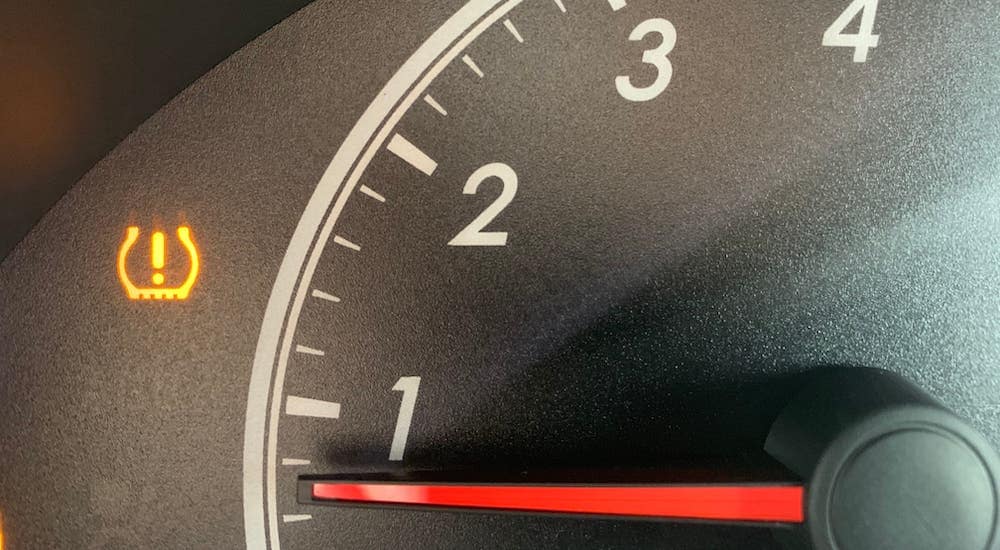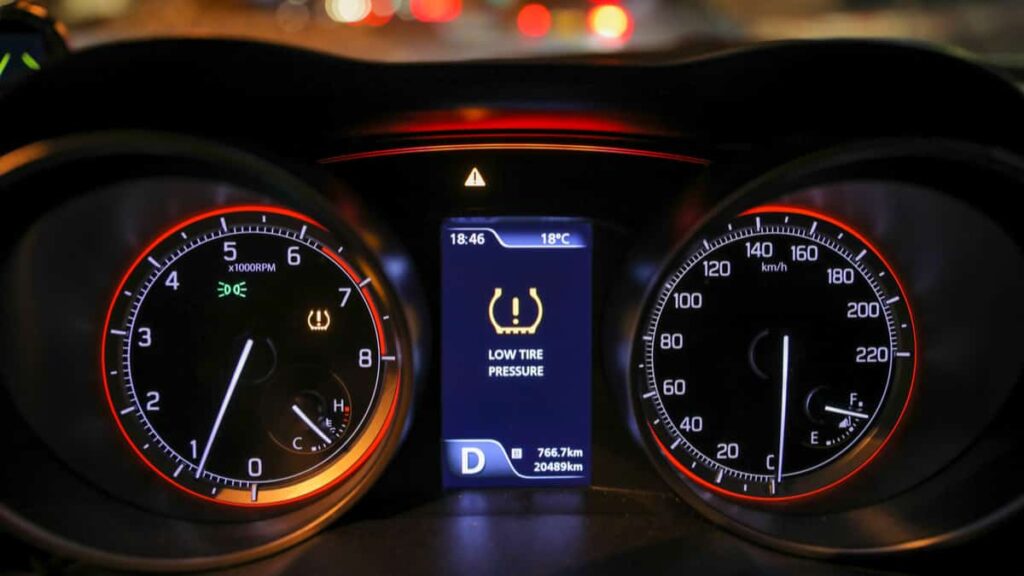
Understanding and keeping up with your vehicle’s tire pressure is an important component of vehicle maintenance. Not only does maintaining the correct tire pressure help extend the life of your tires, but it also helps ensure a smooth and safe ride.
However, many drivers are unfamiliar with what tire pressure is, when the Tire Pressure Light should illuminate, and how to address it when it does. Here, we will provide an overview of the Tire Pressure Light, including what it is, when it should illuminate, and how to resolve the issue.
Tire Pressure Monitoring System Meaning (TPMS)

It is a sensor in the form of a tiny chip installed in each tire of your car. Its main function is to guarantee that the pressure in each tire is appropriate. Sometimes, this is referred to as TPMS.
The TPMS light on your dashboard will illuminate if your tire’s air pressure is 25% below the recommended range, as determined by your chip. Your tires should first be checked to make sure they are properly inflated. In general, there are two categories of sensors:
Direct TPMS
Each car’s four wheels have a sensor in a Direct TPMS system. A signal is sent to the digital receiver when it determines that the tire pressure is too low. The version that appears on new cars the most frequently is this one.
Due to their placement, the sensors are susceptible to wear and tear or damage during tire maintenance or when traveling over difficult terrain. Some versions of this system can employ sensors mounted in the tire valves, where the air intake on each wheel leads.
Indirect TPMS
Indirect TPMS uses sensors mounted on the Anti-Lock Brakes in place of a sensor placed on the wheels. Sensors can also tell if the tire pressure is too low when the rotation speed is too sluggish.
Indirect TPMS is more reliable and less prone to failure than the other two types. Because each wheel’s sensor needs to be activated by the movement for it to work effectively, the drawback of indirect TPMS is that it only informs you if one of your tires is going low.
What to do when the Tire pressure light comes on
Do you know what to do when the TPMS symbol for low tire pressure illuminates? The first step is to physically gauge your tire pressures and add air as necessary to bring them up to the manufacturer’s recommended levels. (The owner’s handbook or the driver’s door jamb will have the proper pressure; the tire’s sidewall will only have the tire’s maximum pressure.)
Remember that your TPMS does not substitute for regular tire pressure checks. Although it is a device that can help notify you when pressure is low, a tire may deflate below the recommended level of inflation long before the TPMS warning light illuminates. When the tire pressure is too low or too high, the TPMS light illuminates.
Things to encounter when the TPMS light is illuminates

When the tire pressure monitoring system (TPMS) warning light is on, you may experience any of the following:
The TPMS light comes on and stays on
At least one of your tires’ pressures is either too low or too high when this happens. It’s recommended to examine your tire for a gradual leak if this happens frequently. Visit a service station with an air compressor as soon as possible and change the pressure as necessary.
TPMS Light Goes On And Off
Changing temperatures could cause your TPMS light to turn on and off when your tire pressure(s) are close to the point where an alert is set off. The indicator may turn out when pressure increases during the day due to rising ambient temperature and heat produced by operating the vehicle; this often happens when pressure lowers at night due to a drop in ambient temperature. Check the pressure in each tire using a gauge and add air to any that need it.
TPMS Light Flashes And Then Stays On
Every time you start your car, if the light flashes for 60 to 90 seconds before staying lit, it signifies the TPMS isn’t working correctly. It would help if you took your automobile to an auto repair shop for a checkup. The TPMS is malfunctioning and unable to alert you to low tire pressure until it is fixed. Using a gauge, check the tire pressure on all of them, and add air to the ones that require it.
Reasons Behind Low Tire Pressure Light but Tires are Fine
The low-pressure indicator on the dashboard frequently illuminates even though the tires are not flat or under-inflated. There are numerous excellent explanations for why this could occur:
Extreme Cold Weather
Winter mornings often cause the low tire pressure indicator, but tires are a good issue. In a tire, hot air expands and increases air pressure. Cold air condenses, decreasing air pressure inside a tire.
An automobile tire may register 30 PSI at 80 degrees during the day, but the next morning, when the temperature drops to 30 degrees as it typically does overnight, it may measure 25 PSI.
Your tire pressure may change by 3 to 5 PSI on days with large temperature swings, such as 40 to 50 degrees F, between day and night. On a frigid winter morning, the low-pressure indication light on your dashboard may illuminate, but the tires will warm up once you start driving. The tire’s air pressure rises, turning off the light. Despite the low tire pressure light, the tires are good.
If the light doesn’t turn off once the tires are warmed up, use your tire pressure gauge to measure and inflate them to the optimal pressure.
Tire Replacement
The TPMS is situated on the tire rim. Therefore, there is a danger that this electronic box will sustain damage when the tires are replaced. Therefore, to avoid returning to the auto shop later, check immediately for the low tire pressure indicator issue if you are going for a car’s tire change.
Additionally, you can use a different tire to replace your old ones if it doesn’t have TPMS like the others or doesn’t have the correct TPMS as required by your car’s manufacturer. When this occurs, it’s as if your car has to re-learn something, which can cause the TPMS light to come on even when the tire pressure is fine.
In this instance, turning off the light needs driving your car at a consistent speed for ten or more minutes. You will probably need to send your car to a professional for an external recalibration if this does not fix the problem.
How to Reset Your Tire Pressure Light
The tire pressure light should turn off when you’ve filled your tires to the required pressure. But if it continues to be on, follow these instructions to reset the tire pressure sensor on your car:
- To reset the sensor, travel at a pace of at least 50 mph for more than ten minutes. The next time you start the engine, your TPMS sensor can reset because of this.
- Turn the key to the “On” position when your car isn’t running, but don’t let the engine start. The tire pressure indicator should blink three times if you continue to hold down the TPMS reset button. Release the button, after which you may start your automobile. Within 20 minutes, the TPMS sensor should re-calibrate. To find the exact placement of the TPMS reset button, see your owner’s handbook. It is often found below the steering wheel.
- All your tires should be inflated to 3 PSI more than is suggested. Then completely deflate them all. Keep in mind that the spare tire can also feature a sensor. Once all of them have been deflated, re-inflate them to the tire’s specified pressure level.
- Disconnect the positive battery cable with the engine off. After putting the automobile in “On,” sound the horn three times. Any remaining power in the vehicle will then be released. After that, reconnect your batteries and carry on with your regular drive.
How to Check Tire Pressure

- Fill to the appropriate level of air pressure. After that, the TPMS light could take a few minutes to reset before going off after a short driving period.
- Use a Separate Tire Pressure Gauge to Check Tire Pressure (which you can get for a reasonable price from most shops). If you don’t have one, seek assistance at a gas station or tire shop.
- For recommended pressure, which may be listed on a label on the driver’s inner door panel, see the owner’s handbook for your car.
FAQs
What Can I Do To Reduce TPMS Warnings?
Completing simple routine maintenance on your car may reduce the likelihood that the TPMS Warning will activate. You should check the tire pressure when you wash your car once a week.
You should get the TPMS sensors checked every four to six months if you often drive large distances or a lot. The wheels should be changed and refurbished before it is fully worn out.
If you have attempted each of these fixes and can still not get your TPMS sensors to function, replacement may be your only remaining choice.
The dealership nearest to you will provide you with diagnostic equipment and perform tests to determine whether you need to replace the sensors if you bring your car in.
How To Fix The TPMS Sensor?
In many circumstances, all necessary to resolve the issue is to confirm that the air pressure in each tire is enough and at the level specified in the manual or indicated on the inside driver door panel.
If the tire pressure indication on your car is on and you can’t find where to reset the tire pressure sensor, you should contact your nearby dealership immediately.
Even if your warranty has expired, changing the TPMS light is often straightforward; hence, the cost of fixing it should be rather low, probably between $100 and $300. Check your warranty to check if it’s still in effect; you might be able to get this fixed for nothing. Alternatively, you could find a reliable neighborhood tire shop that can affordably complete the job.
Conclusion
The under-inflation of one or more of your tires is likely why the tire pressure warning light turns on. You shouldn’t just depend on the information provided by your car’s tire pressure monitoring system since various reasons might cause the sensors to go off even if your tires are in good condition.
No comments:
Post a Comment